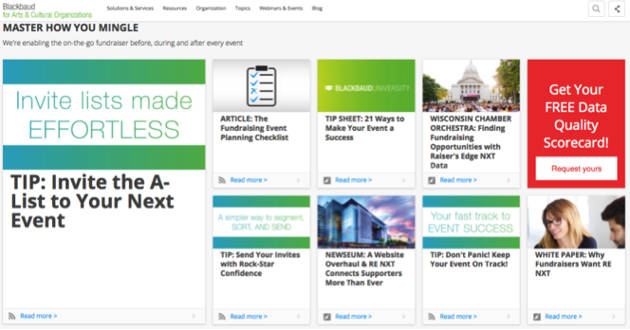One of the first lessons you learn as a content marketer is that your sales prospects don't care about your company. They certainly don't care about your products. But what's absolutely certain is that they do care about themselves.
Smart marketers know that and use it to appeal to their target audience. After all, what good is investing time, dollars, and resources into content creation and distribution if it's going to miss the mark with your prospective customers?
Here are three methods for getting prospects to care about your marketing content.
1. Create content they care about
This first point is an obvious but important one. Start by really understanding your audience and the challenges they face. That begins with defining your buyer personas, fleshing them out, and then unearthing their challenges. You need to understand your prospects on a deeper level to determine what kind of content will resonate with them.
Start by talking to your sales team or listening to recorded calls or demos. Your sales team is on the frontlines, speaking to your target audience every day. Salespeople are constantly uncovering prospect pain on discovery calls and have a wealth of valuable information they can provide to the marketing department. Frankly, they are an untapped resource in most B2B organizations.
You can also attend events, conduct interviews, collect information via surveys and third parties, follow hashtags, scour forums, and turn to the Web to find out what your audience is searching for.
Once you have a full view of their challenges and you have compiled a list of questions your prospects want answered, match those to your content catalog. Find and fill the gaps, and remember that questions shouldn't be answered just on the blog. What about the website, your sales collateral, videos, e-books, and emails? Put your prospects first by leading with a value proposition no matter the content type, and address their needs first.
After you've answered their questions with your content, optimize for search so prospects can easily find the content they search for. While you're at it, make sure to tag your content by persona, topic, and industry so it's found easily internally, too.
2. Don't overlook the experience
Your content might hit the mark, but if the experience around that content is less than ideal, there's a good chance those hard-earned eyeballs won't stick around—and an even greater chance they won't be back.
Now that you're creating content your prospects actually care about, the next step is ensuring the experience doesn't let them down. This is an often overlooked pillar of content marketing: Yes, creation and distribution are important, but we also need to think about how the content we invest so heavily to create and distribute is consumed, how it's presented, and how it's experienced.
The experience can elevate engagement with your content (and your company) or work against you. The data doesn't lie: 65% of buyers will come away from the buyer journey frustrated by inconsistent experiences, according to McKinsey research, and that frustration will cause them to look elsewhere.
If your ultimate goal is to get your prospects to care about your content, then you need to care enough about your prospects to present a remarkable experience.
What do I mean? A content experience is the environment in which your content lives, how it's structured, and how it compels your audience to engage with your company.
As you think about your content experience, consider...
- Is your content easy to read?
- Is the layout attractive, appealing, consistent, and on-brand?
- Have you included interactive elements or visual assets?
- Can visitors find what they're looking for?
- Is content categorized in a way that makes sense for your visitors or for your marketing team, or both?
- Have you assisted prospects on a path not merely to purchase but, more important, to solutions?
Creating a remarkable content experience shows your prospects that you both understand their challenges and can be trusted to solve their problems.
Combining content that resonates with your audience with an optimal experience is a surefire way to get your prospects to care about your content.
3. Personalize the content and the experience
Prospects will care more about your content if they feel it's tailored to them and their specific needs.
Gone are the days when personalization in marketing consisted of "Dear FirstName" in your marketing emails. Prospects want to see themselves reflected in the content they read, and they want to feel understood.
Relevant content recommendations based on your prospects' interests is one way to personalize the experience for them. Another is to include contextual calls to action that make sense for the individual reader and help elevate and personalize the experience.
Prospects who perceive content to be tailored to their specific needs will care about your content, and they'll be more likely to make a decision to purchase.
A great example of personalized content experiences is the way software company Blackbaud builds its email nurture campaigns, including this one. By creating personalized content experiences mapped to nurture campaigns, Blackbaud was able to handpick content and offer strategic content recommendations that naturally drove audiences to nurture faster.

Creating one-to-one personalized experiences can be challenging, but we marketers create personalized experiences on a one-to-some basis every day:
- Think of how we create content for different personas or industries, tailoring content to different job titles and verticals.
- Group those pieces of content together in a collection (which should be easy if you've tagged your content by persona and industry), and add a related call to action to make that experience feel like it was created just for that prospect.
- Follow that up with outreach or nurture emails that make sense for their interests and experiences, and you'll build trust between your company and each prospect.
In the end, you will have gotten them to care about your content by proving you care about them.
* * *
As the saying goes: Know, Like, Trust, Buy. Caring precedes trust, and without trust there will be no purchase. We need our prospects to care about our content.
So get to know your prospects on an intimate level, be customer-centric with your content from ideation all the way to the point of consumption, and combine that content with an experience they can't ignore.




